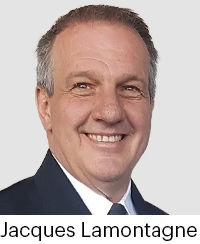
The February 2024 National Summit on Combatting Auto Theft raised high expectations among insurers. “At the time, I said, ‘I hope this won’t just be words and that we’ll see results.’ I have to admit, I’m very surprised and impressed with what’s come out of the Summit,” says Jacques Lamontagne.
Lamontagne, who is Équité Association’s Director of Investigations for Quebec and Atlantic, will retire on May 2, 2025. Insurance Portal spoke with him ahead of his departure, along with his successor, Dominic Monchamp.

The two men have similar backgrounds, having both worked in investigations with the Service de police de la Ville de Montréal (SPVM). Lamontagne began his policing career in 1989 and became a detective about ten years later. After 30 years of service, he joined the Insurance Bureau of Canada (IBC) in 2019 as an investigator for Quebec. He moved to Équité Association in fall 2021 when the unit was transferred to the organization.
Monchamp started as a patrol officer in 1994 and became an investigator a few years later. He notably served as supervisor of the integrated team combatting pimping for four and a half years, up until fall 2021.
Before joining Équité Association in March 2025, he was head of criminal investigations for East Montreal, an area that includes the Port of Montreal—a location well known to investigators as a hub for the export of stolen vehicles.
Although they never worked together, the two former officers crossed paths multiple times. “Our paths have been somewhat parallel,” says Monchamp. “We have tremendous respect for each other, and we share a similar vision of how to work, build partnerships, and respect those we work with. When Jacques approached me, I was truly honoured that he thought of me,” he adds.
“I have big shoes to fill,” Monchamp notes. As SPVM’s head of operations at the Port of Montreal, he saw how his predecessor at Équité Association had helped better coordinate police forces. “He did an exceptional job,” he says.
After years investigating crimes against persons, Monchamp is now turning to property crime. He draws on his experience collaborating with various partners on human trafficking investigations. “Here, we work with partners from across the country and internationally,” he says.
Property crime
“Insurance fraud and auto theft—no one bleeds. There’s no emergency where someone’s life is at risk,” says Lamontagne, reflecting on how Monchamp will need to adapt to his new role.
Another key difference from police work is that Équité Association investigators “don’t have the same powers. We can’t do the same things. We have to rely on contacts and alternative ways to gather information.”
Moreover, the organization does not lead investigations or lay charges. Instead, it supports police agencies, which may charge suspects with public mischief or fraud, and it assists insurers who may deny suspicious claims.
Équité Association is also active in training law enforcement. In September, at the Port of Montreal and at the request of Interpol, the organization hosted about 60 vehicle identification experts from police forces across Canada, from Vancouver to Halifax. “We trained them on how to identify a vehicle at a glance—whether heavy machinery, cars, or even boats that had been targeted—while also learning about how the Port of Montreal operates,” says Lamontagne.
Paper fraud
Among the key changes achieved following the National Summit, Lamontagne highlights access to the list of exported vehicles reported stolen by the Canada Border Services Agency (CBSA).
Many of these vehicles were acquired using fake documents or straw buyers. In several cases, the theft is reported to the insurer weeks after the vehicle has already been exported. With timely access to the list of exported vehicles by Vehicle Identification Number (VIN), Équité Association can provide information that allows insurers to delay payment to supposed theft victims—who may be complicit with the criminal network.
Six months before the Summit, in summer 2023, police forces were made more aware of how vehicle theft funds criminal networks, says Monchamp. SPVM redirected resources to investigations aimed at dismantling networks, rather than simply arresting offenders driving stolen cars.
“A strong connection was made between gun violence in Montreal and vehicle theft. We often found the same types of individuals, the same gangs behind the wheel of stolen cars and involved in armed confrontations,” he explains. Courts gradually began handing out tougher sentences for these property crimes.
Lamontagne notes that the rise in vehicle thefts has affected all policyholders, with premiums increasing in recent years. Consumers raised the issue with their elected officials, who then applied pressure on authorities to take action. The increase in violence tied to organized crime forced everyone to take the issue seriously.
Cargo theft
With such a strong focus on vehicle theft, is there a risk that criminal networks will shift to other activities like cargo theft? Lamontagne doesn’t think so. Historically, about half of all tractor-trailer thefts occur within a few dozen kilometres of Mississauga’s industrial parks in Ontario. Other hot spots include industrial parks in Saint-Laurent and Anjou in the Montreal area.
“Cargo theft rings are well established and well-oiled,” says Lamontagne. “Back in the 2000s, when we conducted searches in Montreal, we found stolen goods from Ontario. Our colleagues in the Toronto area would find stolen cargo from Montreal. It’s still like that today.”
Équité Association lacks the same level of resources to combat cargo theft, as it is a crime with no direct victim. “Insured businesses often don’t report the theft,” says Lamontagne.
High policy deductibles often make it more cost-effective for the carrier to absorb the loss. “That’s the blind spot in cargo theft,” he explains.
Anti-theft systems
Federal elections delayed the update to ULC standard 338 on vehicle anti-theft systems, which Transports Canada was expected to announce in spring 2025. Lamontagne expects the changes to come in fall 2025.
“Manufacturers have developed more than 200 patents accepted in Canada or the U.S. that could improve vehicle theft protection. It’s up to them to implement them,” Lamontagne says.
In his view, manufacturers will do nothing unless the Canadian government mandates a new standard. When a drop in thefts was reported in the first half of 2024, manufacturers were quick to suggest that the solution lay with insurers and law enforcement—not the auto industry.
Two- and three-factor authentication systems using smartphones are now common. Introducing equivalent systems for starting vehicles shouldn’t be too difficult. Voice and facial recognition technologies are also widely available, Lamontagne adds.
“Why is the same vehicle harder to steal in the United Kingdom than in Canada? Because the UK government imposes stricter security standards. It’s a cost issue. If manufacturers can save money by omitting a certain feature, they will,” he says.
Closing the books
Before handing over investigations to his successor, Lamontagne is trying to wrap up outstanding files. One issue he is especially passionate about involves standardizing insurers’ decision-making processes on repatriating vehicles seized abroad. “Right now, it’s the Wild West,” he says.
From one insurer to another, and for the same vehicle seized in the same country, the cost of repatriation can vary by 500 to 600 per cent. In France, an organization called Argos plays a similar role to Équité Association. Whenever a vehicle stolen in France is recovered abroad, Argos decides whether to repatriate or sell it. If repatriated, Argos is reimbursed for the costs.
Équité Association sometimes receives requests from international buyers who, after purchasing a vehicle online and taking delivery, discover that it was reported stolen in Canada. “They ask us to remove the vehicle from the stolen VIN database. That’s not our job. They need to contact local police authorities, who will then notify Interpol, which in turn forwards the request to us,” Lamontagne explains.
He confirms that tighter surveillance at the Port of Montreal has forced criminal networks to shift part of their export operations to the Port of Halifax. “Montreal is still the busiest port for exporting fraudulently obtained or stolen vehicles.”
In a recent seizure, 31 vehicles were found in shipping containers at the Port of Montreal, 16 of which were new vehicles obtained using fake documents to facilitate export. “This type of fraud is harder to detect because the VIN is genuine and hasn’t been altered. The investigation is more complex. Who is the carrier? Who is the recipient?” Lamontagne asks.
“Police forces are working very hard, too. Their investigations have uncovered export warehouses, and they conduct a lot of targeting in coordination with the CBSA,” he adds.
Recovery rates
Quebec has the lowest recovery rate for stolen vehicles in Canada. “Talk to vehicle identification experts and they’ll tell you the best vehicle ‘re-markers’ are in Quebec. We have some top talent,” Lamontagne says.
In Alberta, the most frequently stolen vehicles are F-250 or RAM 3500 trucks built between 2010 and 2012. “They’re stolen for parts. We found a 2013 RAM 3500 in a container at the Port of Montreal. An expert identified parts from seven different vehicles in that one truck. That helps boost Alberta’s recovery rate,” he says.
Monchamp adds that a significant portion of the resources dedicated to vehicle theft by Équité Association, SPVM, the Sûreté du Québec and CBSA are used to recover vehicles at the Port of Montreal. “A large proportion of the vehicles recovered there come from Ontario, other provinces, or even the United States,” he says.
These resources deployed in Quebec benefit police forces in other provinces. “Our capacity isn’t unlimited,” Monchamp adds.
Now that collaboration between crime-fighting organizations is well established, the situation must continue to be closely monitored, Monchamp stresses. “If we become more effective, criminal organizations will adapt and change their methods.”
Fewer vehicles available for theft, thanks to improved security standards, would reduce claims and repatriation costs, Monchamp concludes. That would lower the overall cost of vehicle theft—costs ultimately borne by all insureds through their premiums.







